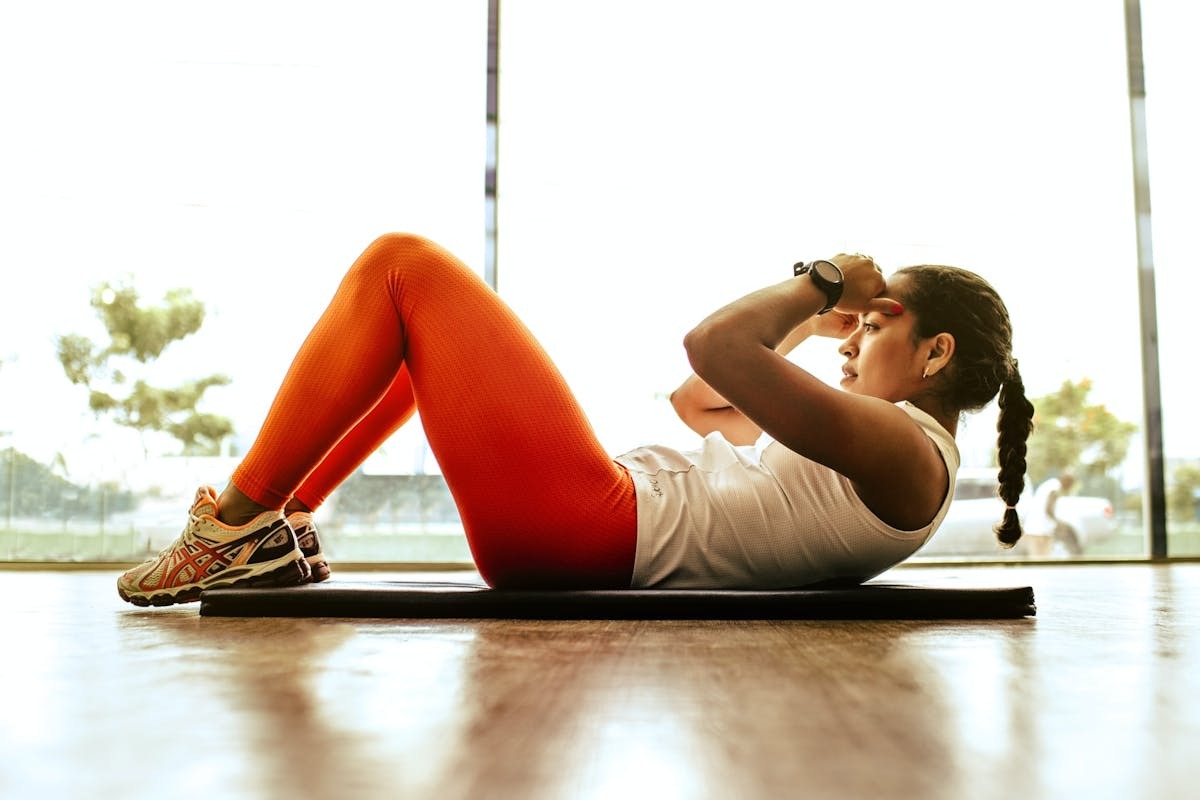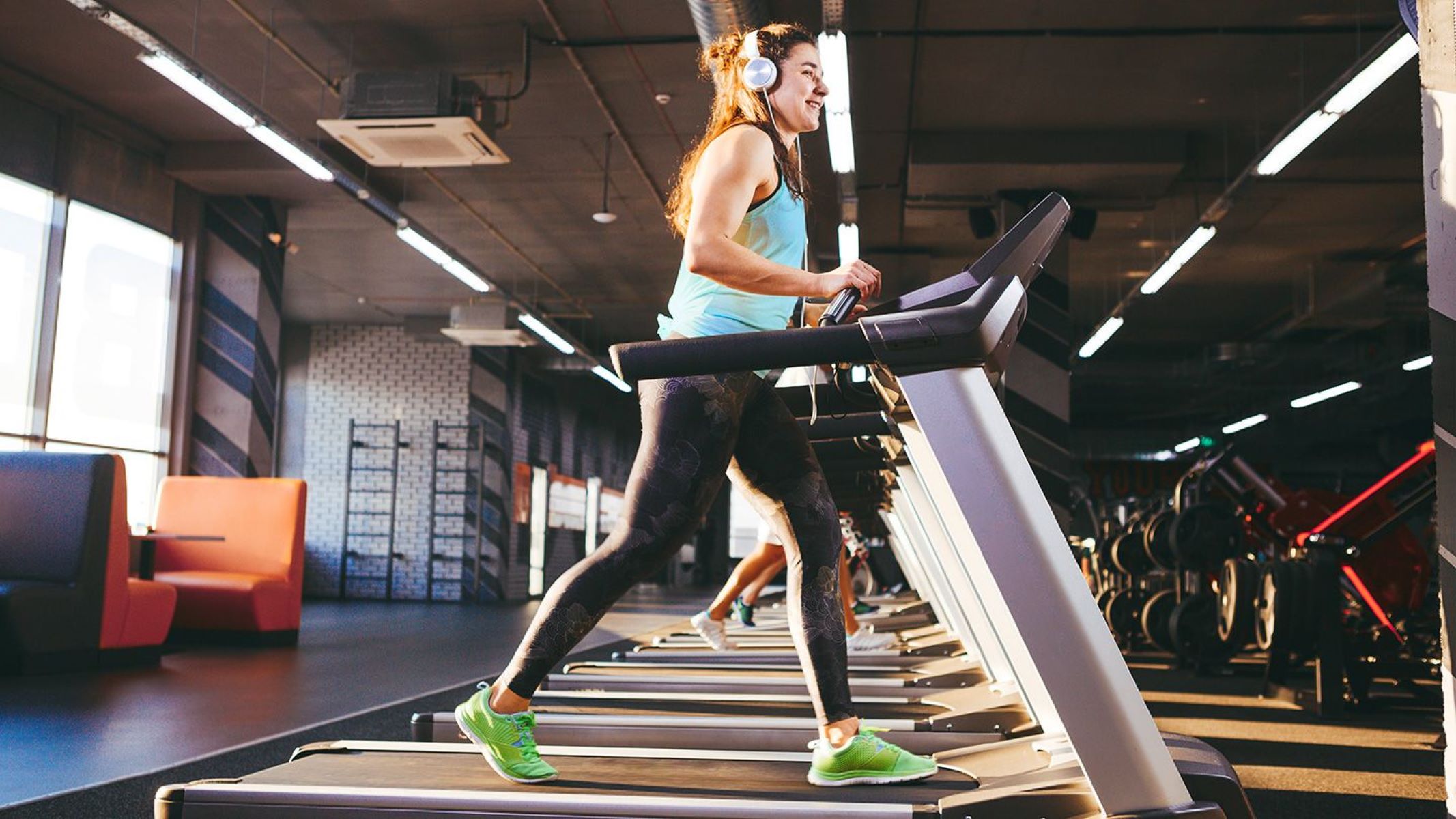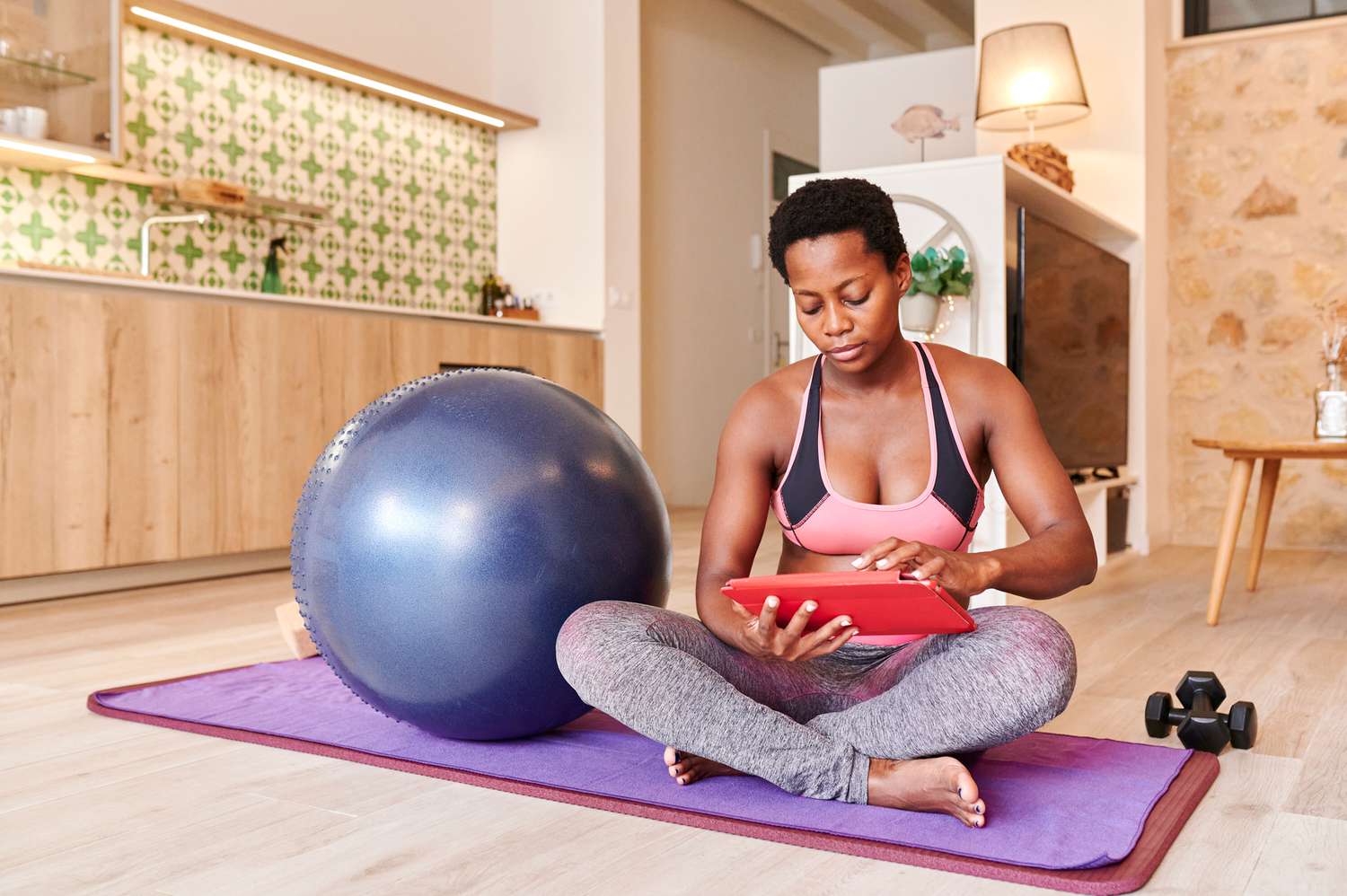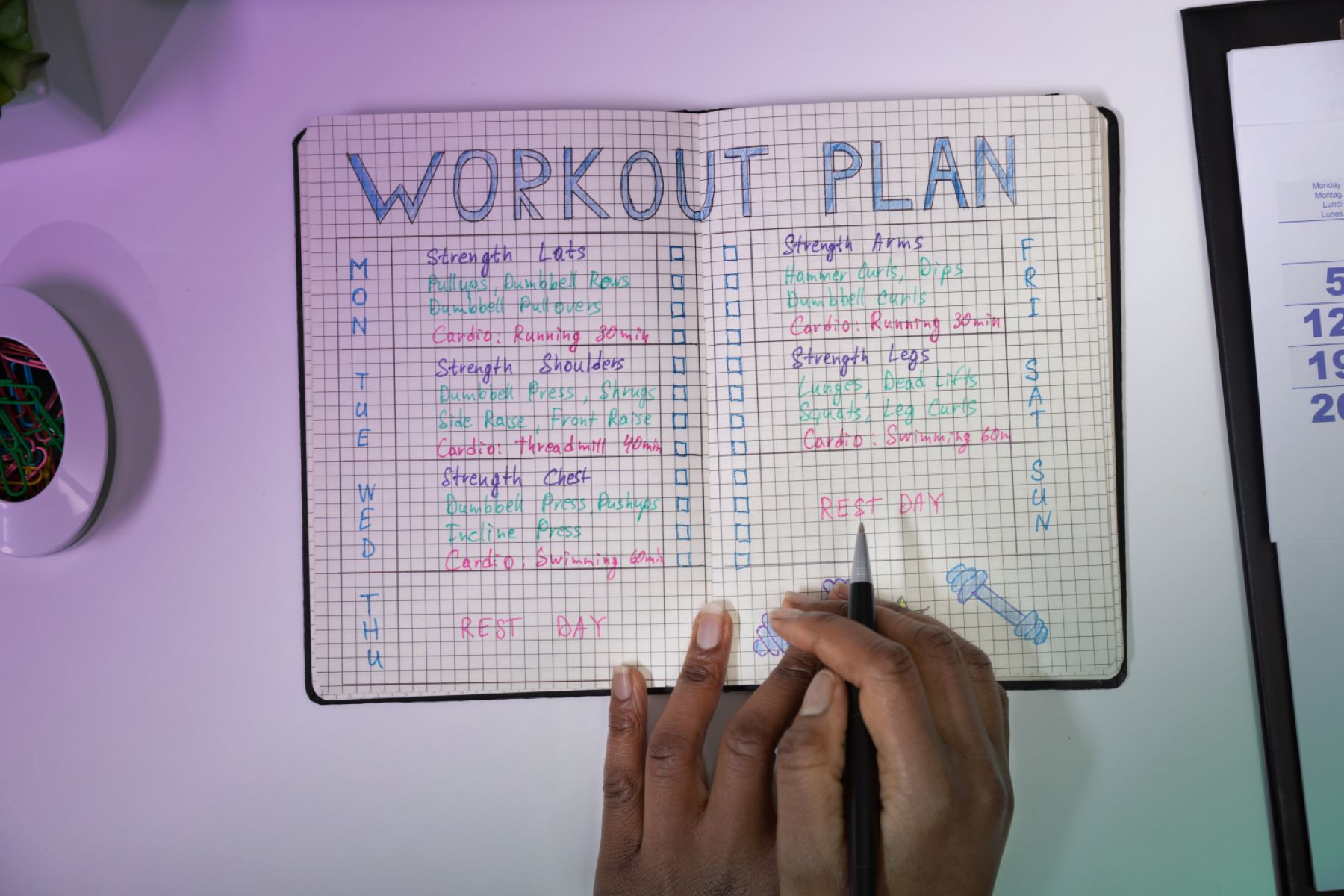

Featured
How To Start An Exercise Routine
Published: October 1, 2023
Learn how to start an exercise routine with our featured guide. Take the first step towards a healthier lifestyle today.
Introduction
Starting an exercise routine is a great way to improve your overall health and well-being. Whether you want to lose weight, increase strength, or simply stay active, regular exercise has numerous benefits for both your physical and mental health. However, embarking on a new fitness journey can be overwhelming, especially if you’re not sure where to begin. Don’t worry, though, as this guide will walk you through the process of starting an exercise routine and provide you with the necessary tools to succeed.
Before diving into the world of exercise, it’s important to determine your goals. This will help you stay focused and motivated throughout your fitness journey. Whether you want to lose a specific amount of weight, build muscle, or improve your endurance, having a clear goal in mind will enable you to tailor your exercise routine accordingly.
Once you have established your goals, the next step is to choose the right exercises. This will depend on your preferences, fitness level, and the resources available to you. If you enjoy running, for example, you might incorporate jogging or sprint intervals into your routine. If you prefer strength training, you can explore options such as weightlifting or bodyweight exercises. Remember to choose activities that you enjoy, as you’re more likely to stick with them in the long run.
Creating a schedule is crucial for maintaining consistency in your exercise routine. Determine how many days a week you can dedicate to exercise and assign specific time slots for your workouts. By treating your workouts as non-negotiable appointments, you’ll be more likely to follow through with them. Additionally, consider varying your workouts to prevent boredom and target different muscle groups.
Having the proper gear and equipment is also essential to ensure a safe and effective workout. Invest in a good pair of athletic shoes that provide support and cushioning for your feet. Depending on your chosen activities, you may also need items such as resistance bands, dumbbells, or a yoga mat. Remember to consult with a fitness professional or do your research to determine what equipment you might need for your specific exercises.
Before each workout, make sure to warm up and stretch properly. This will help increase your flexibility, reduce the risk of injury, and prepare your muscles for the upcoming physical activity. A dynamic warm-up routine that includes exercises such as jogging in place, arm circles, and bodyweight lunges can effectively prepare your body for exercise.
Setting Your Goals
Before you start your exercise routine, it’s important to set clear and realistic goals. Setting goals will not only give you something to strive for, but it will also help you stay focused and motivated throughout your fitness journey.
When setting your goals, it’s important to be specific. Instead of saying, “I want to get in shape,” think about what that means to you. Do you want to lose a certain amount of weight? Do you want to increase your strength or improve your endurance? By having a specific goal in mind, you can tailor your exercise routine accordingly.
It’s also important to make your goals measurable. This means that you can track your progress over time. For example, if your goal is to lose weight, set a specific target, such as losing 10 pounds in three months. This way, you can monitor your progress and make adjustments to your routine if needed.
When setting your goals, make sure they are realistic and achievable. It’s great to aim high, but setting unrealistic goals can lead to disappointment and frustration. Consider your current fitness level, schedule, and any limitations you may have. Set goals that are challenging yet attainable within a reasonable timeframe.
In addition to setting goals related to your physical health, consider setting goals that focus on other aspects of your well-being. For example, you may set a goal to reduce stress through exercise or improve your overall mood and mental clarity. Exercise has numerous mental health benefits, so don’t overlook the impact it can have on your emotional well-being.
Once you’ve set your goals, write them down and keep them somewhere visible. This will serve as a reminder of what you’re working towards and help you stay motivated. You can also break down your goals into smaller, more manageable milestones. Celebrating these smaller victories along the way can provide a sense of accomplishment and keep you motivated to push forward.
Choosing the Right Exercises
Choosing the right exercises is crucial when starting an exercise routine. It’s important to select activities that align with your fitness goals, preferences, and abilities. By choosing exercises that you enjoy and that target specific areas of improvement, you’ll be more likely to stick with your routine and achieve the results you desire.
First, consider your fitness goals. Are you looking to build strength, improve cardiovascular fitness, increase flexibility, or a combination of these? Different exercises and activities will target different areas of fitness. For example, if you’re looking to build strength, you might incorporate weightlifting exercises such as squats, deadlifts, and bench presses into your routine. If improving cardiovascular fitness is your goal, running, cycling, or swimming could be great options.
Next, think about your preferences and interests. It’s much easier to stay motivated when you enjoy the activities you’re doing. If you’re not a fan of traditional gym workouts, consider alternative options like dancing, martial arts, or hiking. Experiment with different activities to find ones that you genuinely enjoy.
Take into account your current fitness level and any physical limitations you may have. If you’re a beginner, it’s important to start with exercises that are appropriate for your fitness level. Gradually increase the intensity and difficulty level as your fitness improves. Additionally, consult with a fitness professional or healthcare provider if you have any specific health concerns or injuries to ensure that you choose exercises that are safe for you.
Variety is essential for a well-rounded exercise routine. Engaging in different types of exercises will give you a full-body workout and prevent boredom. Incorporate a combination of cardiovascular exercises, strength training, and flexibility exercises. This could include activities like brisk walking, swimming, yoga, Pilates, and bodyweight exercises.
If you’re not sure where to start, consider seeking guidance from a personal trainer or fitness professional. They can assess your individual needs and help design a customized exercise program tailored to your goals and abilities.
Remember that it’s okay to experiment and adjust your exercise routine as you go. What works for one person may not work for another, so listen to your body and make modifications as needed. Stay open to trying new exercises and activities to keep your routine fresh and exciting.
Creating a Schedule
Creating a schedule for your exercise routine is essential to ensure consistency and make it a regular part of your daily life. When you have a set schedule, it becomes easier to stick to your workouts and make exercise a habit. Here are some tips for creating an effective exercise schedule:
Firstly, assess your current commitments and time availability. Take a look at your daily and weekly schedule and identify pockets of time that you can dedicate to exercise. This could be in the morning before work, during your lunch break, or in the evening after work. Find a time that works best for you and where you have the least amount of distractions or other responsibilities.
Once you have identified the time slots, allocate specific days for exercise. Aim for at least three to five days a week to get the recommended amount of physical activity. Start with realistic goals, such as committing to exercising three times a week, and gradually increase the frequency as you become more comfortable.
Be mindful of your own energy levels and preferences. Some people are morning exercisers and thrive with early workouts to kickstart their day, while others prefer evening workouts to relieve stress and unwind. Choose a time that aligns with your energy levels and allows you to perform your best during the workout.
Consider the duration of your workouts. On busy days, you might have limited time for exercise, so focus on shorter, higher-intensity workouts. On days when you have more time available, you can incorporate longer workouts or even split your sessions into two shorter ones throughout the day.
Creating a visual schedule or using a fitness app can help keep you organized and accountable. Write down your exercise plan or use a digital calendar to schedule your workouts. Seeing your schedule visually can serve as a reminder and make it feel more like a commitment or appointment.
It’s important to stay flexible with your schedule. Life can sometimes throw unexpected curveballs, and it’s okay to adapt and make changes when needed. If you miss a scheduled workout, don’t beat yourself up about it. Instead, find another time slot to make up for it or adjust your plan for the week accordingly.
Lastly, make sure to prioritize recovery days and rest days within your schedule. Giving your body time to rest and recover is essential for preventing injuries and allowing your muscles to repair and grow stronger. Listen to your body and take rest days when needed.
By creating a schedule for your exercise routine, you are setting yourself up for success. It helps you stay organized, accountable, and consistent in your fitness journey. Remember, the key is to find a schedule that works for you and that you can realistically maintain in the long run.
Getting Proper Gear and Equipment
When starting an exercise routine, having the right gear and equipment is essential for a safe and effective workout. The proper gear can help improve your performance, prevent injuries, and enhance your overall exercise experience. Here are some tips for getting the proper gear and equipment:
1. Athletic Shoes: Invest in a good pair of athletic shoes that provide support and cushioning for your specific activities. Different sports and exercises require different types of shoes, so choose ones that are designed for your chosen activities. Proper shoes will help protect your feet, ankles, and knees from impact and reduce the risk of injuries.
2. Comfortable Clothing: Wear comfortable and breathable clothing that allows for a wide range of movement. Opt for moisture-wicking materials that help keep you dry and comfortable during your workouts. Choose clothing that fits well and doesn’t restrict your movement.
3. Sports Bra: For women, a good sports bra is essential for providing support and reducing bounce during physical activity. Choose a sports bra that fits well and offers the right level of support for your chosen exercises.
4. Hydration Gear: Staying hydrated during exercise is crucial, so invest in a quality water bottle that is easy to carry and allows you to drink fluids while on the go. If you plan on doing longer workouts or endurance activities, consider investing in a hydration pack or belt that allows you to carry larger amounts of water or sports drinks.
5. Fitness Tracker: A fitness tracker or smartwatch can be a great tool for monitoring your progress and tracking important metrics such as heart rate, steps taken, and calories burned. These devices can help you stay motivated and provide valuable feedback on your workouts.
6. Equipment for Specific Activities: Depending on your chosen exercises, you may need specific equipment. For example, if you’re doing strength training, you might need dumbbells, kettlebells, resistance bands, or a weight bench. If you’re interested in yoga or Pilates, invest in a good-quality mat. Research the required equipment for your preferred activities and gradually build up your collection as needed.
7. Safety Equipment: If you’re engaging in high-impact activities or outdoor sports, consider using safety equipment such as helmets, knee pads, or shin guards. Protecting yourself and minimizing the risk of injury is essential, especially in activities that involve contact or potential falls.
8. Consult with Professionals: If you’re unsure about the gear or equipment you need, reach out to fitness professionals or trainers who can provide expert advice and recommendations based on your goals and preferences.
Remember, investing in proper gear and equipment is an investment in your health and safety. Take the time to research, try on, and test different products to find the ones that work best for you and your chosen activities. When you have the right gear, you’ll feel more confident and ready to tackle your fitness goals.
Warming Up and Stretching
Warming up and stretching before your exercise routine is crucial for preparing your body for physical activity, preventing injuries, and optimizing your performance. Incorporating a proper warm-up and stretching routine into your exercise regimen can help improve flexibility, increase range of motion, and enhance overall muscular function. Here are some tips on how to warm up and stretch effectively:
1. Dynamic Warm-Up: Start your warm-up with dynamic exercises that mimic the movements you’ll be performing during your workout. This could include activities such as jogging in place, arm circles, lunges, or jumping jacks. Dynamic movements increase blood flow to your muscles and help raise your body temperature, preparing your body for the upcoming activity.
2. Cardiovascular Activity: Incorporate brief periods of cardiovascular exercise into your warm-up to further elevate your heart rate and increase blood circulation. This can be done through activities such as brisk walking, jumping rope, or cycling. Gradually increase the intensity as your warm-up progresses.
3. Stretching: After your warm-up, it’s important to stretch your muscles to optimize their flexibility. Focus on static stretching, which involves holding a stretch for 15-30 seconds without bouncing. Target major muscle groups such as your calves, hamstrings, quadriceps, glutes, and shoulders. Remember to breathe deeply and relax into each stretch, without forcing or causing pain.
4. Focus on Full-Body Stretching: Ensure that you stretch all major muscle groups, not just the ones you’ll be working during your workout. This will help maintain overall flexibility and balance in your body. Include stretches for your chest, back, arms, and neck, along with the leg stretches mentioned earlier.
5. Avoid Overstretching: Stretching should be done with control and without pain. Avoid bouncing or jerking during stretches, as this can lead to injury. Instead, focus on a gentle and gradual stretch to the point of tension, not discomfort. If a stretch feels too intense, back off slightly and find a comfortable level.
6. Incorporate Foam Rolling or Self-Myofascial Release: Consider using a foam roller or other self-massage tools to release tension in your muscles before your workout. Foam rolling can help loosen tight muscles and improve mobility, preparing your body for movement.
7. Customize Your Warm-Up and Stretching Routine: Tailor your warm-up and stretching routine to your specific activities and personal needs. If you’re doing a specific sport or exercise, incorporate movements and stretches that target the muscles and joints involved in that activity. Additionally, if you have any existing injuries or areas of tightness, include stretches or foam rolling techniques that address those specific areas.
8. Warm-Up and Stretching for Cool-Down: Remember to cool down with light aerobic exercise and gentle stretching after your workout. This will help gradually lower your heart rate and prevent the build-up of lactic acid, reducing muscle soreness and aiding in the recovery process.
By incorporating a proper warm-up and stretching routine into your exercise regimen, you’ll be setting yourself up for success. Warming up prepares your body for the upcoming activity, while stretching helps improve flexibility and prevent injuries. Be consistent and mindful of your warm-up and stretching routine to optimize your workouts and maximize your performance.
Starting Slow and Gradually Increasing Intensity
When starting an exercise routine, it’s important to start slow and gradually increase the intensity of your workouts. This approach allows your body to adapt and prevents the risk of injuries. By starting slow and building up gradually, you can create a sustainable routine that you can maintain in the long run. Here are some tips to help you get started:
1. Listen to Your Body: Pay attention to how your body feels during and after exercise. If you’re just starting out or returning to exercise after a long break, it’s normal to experience some muscle soreness. However, if you’re in pain or feel excessively fatigued, it’s a sign that you may be pushing yourself too hard. Always listen to your body’s cues and adjust the intensity or duration of your workouts accordingly.
2. Start with Low-Impact Exercises: If you’re new to exercise or have joint concerns, consider starting with low-impact exercises such as walking, swimming, or cycling. These activities put less stress on your joints while still providing the cardiovascular benefits of exercise. As your fitness improves, gradually incorporate higher-impact activities if desired.
3. Set Realistic Goals: Setting realistic goals is essential when starting an exercise routine. Don’t expect to achieve overnight results or jump straight into intense workouts. Start with attainable goals and gradually work your way up from there. Celebrate small victories along the way to stay motivated and encouraged on your fitness journey.
4. Increase Duration Before Intensity: Begin by focusing on increasing the duration of your workouts rather than pushing for intense exercises right away. For example, if you’re walking, start with shorter distances and gradually increase the time spent walking. Once you feel comfortable with the duration, you can then start adding intervals of higher intensity or incorporating strength training exercises.
5. Use the Talk Test: During your workouts, use the talk test as a gauge of intensity. If you’re able to carry on a conversation without feeling breathless or unable to speak, you’re likely at a moderate intensity level. If you’re unable to speak more than a few words without gasping for breath, you may be pushing yourself too hard. Adjust your pace or intensity accordingly.
6. Gradually Increase Intensity and Frequency: As you become more comfortable with your exercise routine, gradually increase the intensity and frequency of your workouts. This could include adding more resistance, increasing the speed or incline, or trying more challenging variations of exercises. Aim to challenge yourself without overexerting, and give your body time to adapt to the increased demands.
7. Incorporate Rest Days: Rest days are just as important as exercise days. Allow your body time to recover and repair itself between workouts. Rest days can help prevent burnout, reduce the risk of overuse injuries, and improve your overall performance. Listen to your body and adjust your exercise schedule as needed to include regular rest days.
8. Seek Professional Guidance: If you’re unsure about how to safely increase the intensity of your workouts, consider seeking guidance from a certified fitness professional. They can provide you with personalized advice and help create a progressive exercise plan based on your goals and abilities.
Remember, starting slow and gradually increasing intensity is the key to building a sustainable exercise routine. Be patient with yourself and allow your body time to adapt. Consistency is more important than intensity in the beginning. Focus on making exercise a habit and gradually challenging yourself as your fitness level improves.
Staying Consistent and Motivated
Staying consistent and motivated is crucial when it comes to maintaining an exercise routine. While starting on a fitness journey can be exciting, it’s common to face challenges and moments of demotivation along the way. However, with the right strategies, you can stay focused and on track to achieve your fitness goals. Here are some tips to help you stay consistent and motivated:
1. Set Realistic Goals: Start by setting realistic and achievable goals. Break them down into smaller milestones that you can track and celebrate along the way. Having clear goals will provide you with a sense of direction and help you stay motivated.
2. Find Your Why: Discover the underlying reasons why you want to exercise and stay healthy. Whether it’s to improve your overall well-being, have more energy, or be a positive role model for your loved ones, understanding your motivations will help you stay committed during challenging times.
3. Establish a Routine: Create a schedule and make exercise a regular part of your daily or weekly routine. Treat it as a non-negotiable appointment with yourself, just like any other important commitment. By making it a habit, it becomes easier to stay consistent and motivated.
4. Embrace Variety: Avoid falling into a monotonous exercise routine by diversifying your workouts. Try different activities, classes, or workout styles to keep things interesting and challenge your body in new ways. Variety can help prevent boredom and maintain your motivation levels.
5. Find Accountability: Seek a workout buddy or join a fitness community to hold yourself accountable and stay motivated. Having someone to share your progress, challenges, and achievements with can greatly enhance your motivation and help you stay consistent.
6. Track Your Progress: Keep a record of your workouts, measurements, and other relevant metrics. Tracking your progress will allow you to visually see how far you’ve come, which can be a powerful motivator. Use fitness apps, fitness journals, or simple spreadsheets to monitor your achievements.
7. Reward Yourself: Treat yourself to small rewards when you reach milestones or achieve specific goals. This could be buying new workout gear, enjoying a relaxing massage, or indulging in a guilty pleasure (in moderation). Rewarding yourself reinforces the positive behaviors and progress you’ve made.
8. Seek Inspiration: Surround yourself with motivational content, whether it’s reading fitness blogs, following inspiring social media accounts, or listening to podcasts. Seeing others’ success stories and hearing their tips can reignite your motivation and give you fresh ideas for your own fitness journey.
9. Be Kind to Yourself: Set realistic expectations and be patient with yourself. Understand that progress takes time, and setbacks are a normal part of any fitness journey. Be gentle with yourself and remember that each day is an opportunity to start fresh.
10. Celebrate Non-Scale Victories: Shift your focus from solely relying on the scale. Celebrate non-scale victories such as improved strength, increased endurance, better sleep, enhanced mood, and improved self-confidence. These non-physical changes are just as important and can provide motivation alongside any changes in weight or body composition.
Remember that staying consistent and motivated is a journey in itself. Be flexible and adaptable when challenges arise, and don’t be too hard on yourself. Celebrate your accomplishments, big or small, and allow yourself to enjoy the process. With determination, patience, and the right mindset, you can stay motivated and achieve your fitness goals.
Monitoring Your Progress
Monitoring your progress is an essential component of any successful exercise routine. By keeping track of your achievements and assessing your progress over time, you can stay motivated, make necessary adjustments, and celebrate your accomplishments. Here are some strategies for effectively monitoring your progress:
1. Establish Baseline Measurements: Start by recording baseline measurements of your weight, body measurements, and fitness level. This can include measurements such as waist circumference, body fat percentage, or the number of repetitions you can perform for certain exercises. These initial measurements will serve as a starting point to track your progress.
2. Keep a Workout Journal: Take note of your workouts in a journal or a fitness app. Include details such as the exercises performed, the intensity, duration, and any variations made. By documenting your workouts, you can see how you’ve progressed and ensure that you are continually challenging yourself.
3. Track Performance Goals: Set specific performance goals related to your exercises or activities of choice. For example, you might aim to run a certain distance within a specific time frame, increase your maximum weight lifted, or improve your flexibility. Regularly assess your performance and track your progress towards these goals.
4. Utilize Fitness Apps and Wearable Devices: Take advantage of technology to track and monitor your progress. Fitness apps and wearable devices can provide data such as heart rate, steps taken, calories burned, and sleep patterns. They can offer insights into your activity levels and progress, helping you stay accountable and motivated.
5. Take Progress Photos: Visual progress can be a powerful motivator. Take before-and-after photos and compare them periodically. Seeing the physical changes in your body can be inspiring and reinforce your dedication to your exercise routine.
6. Regularly Assess Fitness Level: Periodically assess your fitness level by retesting yourself on specific exercises or activities. This will allow you to see improvements in strength, endurance, or flexibility. Consider performing fitness tests such as a timed run, plank hold, or flexibility assessments to gauge your progress.
7. Monitor Energy Levels and Recovery: Pay attention to your energy levels and recovery rate. If you notice consistent improvements in energy levels, reduced fatigue during workouts, and faster recovery after exercise, it’s a good sign that your fitness level is improving. Conversely, if you feel excessively fatigued or notice a decline in performance, it may indicate a need for adjustments to your routine or a focus on recovery strategies.
8. Assess Non-Physical Indicators: Progress is not solely measured by physical changes. Pay attention to non-physical indicators of progress such as improved mood, increased energy throughout the day, better sleep quality, or reduced stress levels. These factors can indicate that your exercise routine is positively impacting your overall well-being.
9. Regularly Revisit and Adjust Goals: Review your goals periodically and adjust them as needed. As you progress and achieve certain milestones, set new goals or raise the bar for existing ones. This continuous goal-setting process will maintain your focus and help you strive for new heights.
10. Celebrate Milestones: Celebrate your progress and achievements along the way. Set milestones and reward yourself when you reach them. This can help boost your motivation and reinforce the positive habits you’ve developed.
Monitoring your progress is not only about achieving specific numbers or physical changes; it’s about understanding and appreciating the journey. Embrace the process, learn from setbacks, and celebrate the incremental improvements that lead to long-term success.
Listening to Your Body
One of the most important aspects of any exercise routine is learning to listen to your body. Your body has its own way of communicating its needs, limits, and signals. By paying attention to these cues and responding accordingly, you can ensure a safe, enjoyable, and effective workout experience. Here’s why it’s crucial to listen to your body:
1. Avoiding Injury: Your body is equipped with internal warning signs that indicate the potential for injury. By paying attention to these signals, such as sharp pain, discomfort, or excessive fatigue, you can prevent serious harm. Don’t push through pain or ignore persistent discomfort. Instead, modify or stop the exercise as needed and consult with a healthcare professional if necessary.
2. Understanding Your Limits: Every individual is unique, and each body has its own limits and capabilities. Recognizing and respecting your own limits is crucial to prevent overexertion, exhaustion, or burnout. Push yourself, but also know when to take a step back and allow for rest and recovery.
3. Differentiating Between Discomfort and Effort: There’s a distinction between the discomfort that accompanies physical exertion and actual pain. The burning sensation in your muscles during a challenging workout is normal, but sharp or stabbing pain is not. Learn to differentiate between the two, and don’t hesitate to modify or stop an exercise if you feel genuine pain.
4. Adjusting Intensity and Volume: Your body’s needs can vary from day to day. Some days you may feel energized and full of stamina, while others you may feel fatigued or low on energy. By tuning in to these fluctuations, you can adjust the intensity and volume of your workouts accordingly. It’s perfectly fine to take lighter or shorter sessions when your body signals the need for a gentler approach.
5. Recognizing the Impact of Stress and Rest: Exercise is meant to be a stress-relieving activity. However, chronic stress, lack of sleep, or a busy lifestyle can accumulate and affect your body’s ability to recover and adapt. If you’re feeling overly stressed, fatigued, or struggling with sleep, consider adjusting your exercise routine to allow for more rest and recovery. Balance is key to maintaining a healthy and sustainable fitness routine.
6. Paying Attention to Recovery: Your body requires adequate rest and recovery to repair and grow stronger. Ignoring signs of overtraining or not allowing enough time for recovery can lead to diminishing returns and increased injury risk. Listen to your body’s signals for rest and prioritize recovery days and periods within your routine.
7. Tuning into Your Energy Levels: Pay attention to your energy levels throughout the day or during workouts. If you consistently feel drained or lack the necessary energy to complete your sessions, it might be an indication of other factors affecting your body’s balance, such as improper nutrition, sleep deprivation, or underlying health issues. Address these factors to optimize your energy levels and overall well-being.
8. Recognizing Personal Preferences: Your body’s preferences are essential to keep your exercise routine enjoyable and sustainable. If you discover that you genuinely dislike a particular form of exercise or a specific workout style, it’s okay to explore alternatives that align better with your preferences and keep you motivated.
Listening to your body is a skill that develops over time. It requires self-awareness, patience, and a genuine willingness to prioritize your well-being. Remember that your body is unique, and what works for someone else may not work for you. Trust yourself, be mindful of your body’s signals, and make choices that foster a healthy and rewarding relationship with exercise.
Modifying and Adjusting Your Routine
As you progress in your fitness journey, it’s important to regularly modify and adjust your exercise routine to continue challenging your body and achieving your goals. Sticking to the same routine for an extended period can lead to a plateau in results or decreased motivation. By making necessary modifications and adjustments, you can keep your workouts fresh, exciting, and effective. Here’s how to modify and adjust your routine:
1. Evaluate Your Current Routine: Start by assessing your current exercise routine. Reflect on what’s been working well and what might need improvement. Consider factors such as the exercises, intensity, duration, frequency, and variety of your workouts.
2. Set New Goals: Review your goals and set new targets to work towards. Having specific and measurable goals will guide your modifications and keep you focused. Whether it’s increasing your strength, improving endurance, or participating in an event, clearly define what you want to achieve.
3. Introduce New Exercises: Incorporate new exercises to challenge different muscles, improve overall fitness, and prevent boredom. Explore different workout styles, such as HIIT, circuit training, or dance fitness. You can also experiment with various equipment and try new classes or activities to keep your routine enjoyable and dynamic.
4. Increase Intensity: Gradually increase the intensity of your workouts to continue pushing your limits and progressing. This can be done by adding resistance (e.g., using heavier weights), increasing the duration or intensity of cardiovascular exercises, or incorporating interval training. Progressive overload is key to ongoing improvements.
5. Adjust Frequency and Duration: Consider adjusting the frequency and duration of your workouts based on your goals, time availability, and recovery needs. If you’ve been exercising every day, you might benefit from incorporating rest days to allow for proper recovery. Alternatively, if you’re finding your current routine doesn’t challenge you enough, increase the number of workout days to meet your goals.
6. Vary Your Training Split: If you follow a specific training split, such as targeting different muscle groups on different days, change it up occasionally. Experiment with new splits or rearrange your current split to work different muscle groups on different days. This can prevent muscle adaptation and ensure balanced development.
7. Incorporate Periodization: Periodization involves dividing your training cycle into different phases, each with a specific focus and level of intensity. This allows for systematic progression and optimization of performance. Include periods of higher intensity, lower volume training, as well as recovery phases to prevent overtraining and enhance results.
8. Listen to Your Body: Pay attention to how your body responds to your current routine. If you experience persistent fatigue, lack of progress, or other signs of overtraining, it may be time to adjust your routine to allow for proper rest and recovery. Additionally, if you encounter any physical limitations or injuries, modify exercises or seek professional guidance to ensure safe and effective workouts.
9. Stay Flexible: Be flexible and adaptable with your routine. Life circumstances, work commitments, and other factors may require you to modify your workout schedule or adjust the type of exercises you’re doing. Embrace these changes and find creative solutions to keep your fitness journey on track.
10. Continually Assess and Reassess: Regularly assess your progress and reassess your routine to make sure it aligns with your goals and preferences. As you evolve and develop, your routine should evolve with you. Stay curious, explore new ideas, and be open to trying new things to find what works best for you.
Modifying and adjusting your exercise routine is essential for long-term success and continued progress. By regularly assessing, challenging, and fine-tuning your routine, you’ll ensure ongoing improvements and maintain the motivation needed to achieve your fitness goals.









